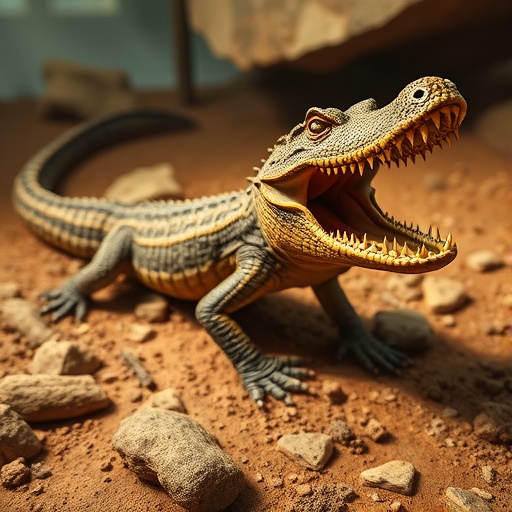A remarkable discovery from the depths of Brazil’s Triassic strata has unveiled a new carnivorous reptile species that rewrites part of the evolutionary narrative preceding the age of dinosaurs. This newly identified archosaur, dubbed Tainrakuasuchus bellator, represents a lineage closely related to modern-day crocodilians yet showcases unique adaptations that underscore the ecological complexity of terrestrial ecosystems approximately 240 million years ago. The revelation of this species offers unprecedented insights into pseudosuchian diversity and the paleobiogeography of the supercontinent Pangaea during a pivotal epoch in vertebrate history.
Tainrakuasuchus bellator emerges as a formidable predator within its ancient milieu, characterized by an elongated neck and a lithe, agile body estimated to be approximately 2.4 meters in length, with a mass around 60 kilograms. These dimensions situate this species as a mid-sized carnivore relative to megafaunal contemporaries, some measuring in excess of seven meters. The finely recurved dentition and slender jaw architecture of this reptile indicate a predatory strategy reliant on rapid, precise strikes followed by a sustained grip exerted by the jaw’s morphology, optimized for preventing escape of its prey. This level of specialization highlights intricate trophic relationships and hunting strategies employed during the Middle Triassic.
Phylogenetically, Tainrakuasuchus bellator belongs to the Pseudosuchia clade, which encompasses ancestors of crocodilians but distinctly excludes dinosaurs. The anatomical evidence, particularly the unique pelvic structure and femoral articulation, distinctly demarcates it from Saurischian and Ornithischian dinosaur groups. This differential morphology affirms the taxonomic boundaries used to discern archosaur phylogeny and sheds light on the evolutionary divergences that shaped the archosaur lineage. Such detailed osteological analysis was achieved through painstaking fossil preparation and comparative anatomy methodologies.
The fossil discovery was made during the 2025 excavation in the municipality of Dona Francisca, southern Brazil. The partial skeleton includes key elements such as the lower jaw, vertebral column, and pelvic girdle, with notable osteoderm coverage preserved across the back. These bony dermal plates, homologous to those in modern crocodilians, affirm the armored nature of this predator and suggest a level of defensive adaptation. Despite absence of limb preservation, functional morphological inference based on close relatives strongly supports quadrupedal locomotion.
The nomenclature of this species integrates indigenous Guarani terms with classical Greek, reflecting both biological and cultural significance. “Tainrakuasuchus” translates to “sharp-toothed crocodile,” with “tain” and “rakua” referring to “tooth” and “pointed” respectively, combined with “suchus” from Greek meaning crocodile. The species epithet “bellator,” Latin for “warrior,” honors the resilience of Rio Grande do Sul’s people, particularly in the context of recent regional adversities. This cultural tribute underscores the interconnectedness of scientific discovery and human experience.
Ecologically, Tainrakuasuchus bellator occupied a niche within a diverse predator assemblage where size and hunting strategies varied widely. This diversity suggests complex ecosystem structuring and niche partitioning among pseudosuchines during the Middle Triassic. The presence of such a predator in arid landscape margins, adjacent to environments where early dinosaurs emerged, indicates overlapping yet distinct evolutionary trajectories and habitat preferences within terrestrial vertebrate guilds.
The investigation into Tainrakuasuchus bellator also illuminates the paleogeographic continuity of Late Permian–Early Triassic faunas across what is now South America and Africa. The close phylogenetic relationship with Mandasuchus tanyauchen, a pseudosuchian from present-day Tanzania, exemplifies biotic exchange facilitated by the supercontinent Pangaea’s contiguous landmass. This pan-Pangaean dispersal emphasizes the role of continental assembly in shaping global biodiversity and evolutionary pathways during the Triassic.
From a methodological standpoint, the research employed meticulous laboratory preparation to extract the fossil from encasing matrix, enabling detailed morphological assessment. This process underscores the importance of advanced paleontological techniques in reconstructing ancient life and refining systematic classifications. The rigorous anatomical and phylogenetic analyses presented in the study contribute significant data for understanding archosaur evolution and paleoecology.
The discovery reaffirms that despite the dominance of dinosaurs in subsequent epochs, pseudosuchians were paramount players in early Mesozoic ecosystems. Their varied sizes, morphologies, and behavioral adaptations reflect evolutionary experimentation within archosaur lineages and illustrate the dynamic evolutionary landscape of the Triassic Period. Tainrakuasuchus bellator stands as a testament to the complex interplay of anatomy, ecology, and biogeography that governed prehistoric predator-prey dynamics.
Moreover, Tainrakuasuchus bellator enriches our comprehension of vertebrate adaptation in response to climatic and environmental pressures characteristic of its era. The species thrived in an environment bordering extensive deserts, a setting that likely imposed selective pressures driving the evolution of diverse survival strategies. This ecological backdrop provides context for understanding vertebrate diversification immediately predating dinosaur ascendancy.
The significance of this research transcends taxonomy, offering a window into ecosystem resilience and adaptive innovation during periods of major biotic turnover. By elucidating the anatomy and relationships of a previously unknown pseudosuchian, the study fills critical gaps in our understanding of Triassic archosaur phylogeny and ecology, thereby enhancing the broader narrative of terrestrial vertebrate evolution.
In summary, the unveiling of Tainrakuasuchus bellator marks a milestone in paleontological research, combining comprehensive osteological study with an appreciation for paleoecological and paleobiogeographic contexts. This species not only exemplifies a distinct evolutionary branch of armored predators but also embodies the scientific spirit of discovery illuminating past biodiversity and environmental dynamics.
Subject of Research: Not applicable
Article Title: Osteology, taxonomy and phylogenetic affinities of a new pseudosuchian archosaur from the Middle Triassic of southern Brazil
News Publication Date: 13-Nov-2025
Web References: http://dx.doi.org/10.1080/14772019.2025.2573750
Image Credits: Caio Fantini, Rodrigo Temp Müller, Mauricio Garcia
Keywords: Tainrakuasuchus bellator, pseudosuchian, archosaur, Middle Triassic, Brazil, osteoderms, paleobiogeography, Pangaea, predator evolution, crocodilian ancestors, fossil discovery, Triassic ecosystem




